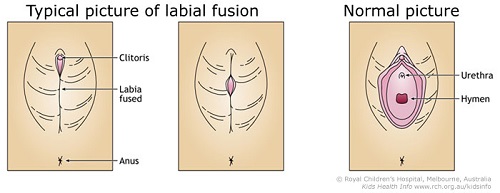Labial fusion is a condition where the two flaps of skin on either side of the opening to the vagina (the labia minora) are joined together. It is also sometimes called labial adhesion or agglutination. Labial fusion is a common condition, and there is
no need for concern in most cases.
The fusion (join) will usually separate by itself by the time your child reaches puberty. Treatment is not usually needed or recommended because it can cause your child pain and anxiety. There is also a risk that the fusion will return if any treatment
is carried out.
The exact cause of labial fusion is not known, but sometimes it occurs after an inflammation of the labial area (e.g. after a simple infection such as vulvovaginitis, or after mild trauma to the area).
Signs and symptoms of labial fusion
Labial fusion is almost never present at birth, but usually develops around one to two years of age. If your child has labial fusion, instead of two separate labia, you will be able to see the labia joined together. There are not usually any other symptoms.
There will usually be a small opening in the join – even if it is very small (one millimetre or more) there will be enough space for urine (wee) to drain.

If you think your child has labial fusion, take them to be seen by the GP.
Treatment for labial fusion
The join usually separates naturally by the time your child reaches puberty. This happens slowly. There is no pain and your child will not notice it happening.
Treatment is not usually needed. If the labial fusion is causing significant problems (e.g. problems urinating), treatment options may include gentle massage or applying oestrogen cream. Surgery to pull apart the labia is a last resort, but it is not
recommended as there is a high risk that the fusion will return.
Leaving labial fusion alone is the safest and most effective treatment.
There is no relationship between labial fusion and any other medical conditions. Labial fusion will not have any effect on your child's future ability to have sexual intercourse or have babies.
When to see a doctor
If the labial fusion is causing significant problems (e.g. problems urinating), see a GP. Very occasionally, a child with labial fusion may get a urinary tract infection (UTI). This is not common and can usually be treated simply and effectively. Take
your child to the GP if they experience pain or burning when they do a wee. See our fact sheet
Urinary tract infection.
Key points to remember
- Labial fusion is common and does not usually cause any other symptoms.
- The fusion will normally separate naturally by the time your child has their first period.
- The safest, most effective and least stressful thing to do is no treatment.
For more information
Common questions our doctors are asked
Is there any way to prevent labial fusion?
While doctors are not sure exactly how labial fusion occurs, it often seems to happen following an infection in the vulval area, such as vulvovaginitis, or after minor trauma, like a injury from horse riding. Ways to prevent vulvovaginitis
include wearing cotton underwear and avoiding harsh or perfumed soaps in the bath or shower.
Will my daughter's labia look normal after the labial fusion
gets better?
Yes. After the labia have separated, which in most cases happens on its own by puberty, there will be no lasting damage to the labia. Your daughter will be able to menstruate without problems, and her future fertility and ability to have sexual
intercourse will not be affected.
Call an ambulance (000) immediately in an emergency.
Developed by The Royal Children's Hospital Gynaecology department. We acknowledge the input of RCH consumers and carers.
Reviewed May 2018.
This information is awaiting routine review. Please always seek the most recent advice from a registered and practising clinician.